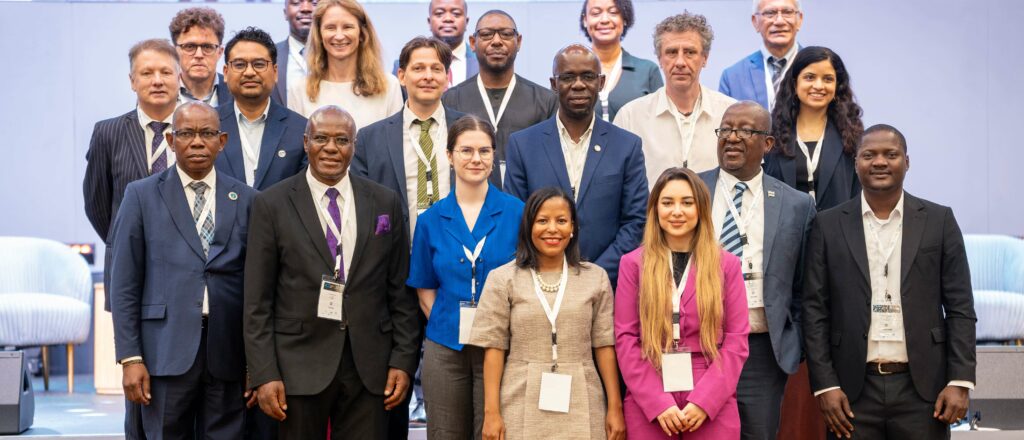Powering the Future, Bridging Regions, Energizing Change: Reflections from the First SADC Sustainable Energy Week

The first-ever SADC Sustainable Energy Week (SADCSEW) in Gaborone, Botswana, was more than just a gathering of experts—it was a resounding call to action for the energy transition in the Southern African Development Community (SADC) region. As the Head of Partnerships and Programmes at the Caribbean Centre for Renewable Energy and Energy Efficiency (CCREEE), I was honoured to attend, represent the Caribbean’s perspective, and engage with some of the most determined minds working towards a more sustainable energy future.
Walking into the Gaborone International Convention Centre, the air was electric with anticipation. Government officials, private sector leaders, researchers, development partners, civil society, and young energy entrepreneurs converged with a shared goal: to accelerate sustainable energy solutions for an energy-secure SADC region. It felt like a moment in history—one where alliances were forged, ideas sparked, and commitments made.
As I reflect on the week, several recurring themes stood out. The power of regional collaboration cannot be underestimated or reinforced enough. One of the strongest messages throughout the event was the undeniable power of regional cooperation. The Southern African Centre for Renewable Energy and Energy Efficiency (SACREEE), the host institution, showcased its efforts to drive energy integration in the region, emphasizing the importance of cross-border collaboration. The Caribbean, with its own experience in regional energy coordination through the CCREEE understands this well. Our anticipated work on pooled procurement, harmonized regulatory frameworks, and existing integrated energy planning (IRRPs) mirrors SADC’s aspirations. It was inspiring to see how different regions, despite similar but unique challenges, are aligned in their pursuit of collective energy security.
A key mechanism driving this regional collaboration is the Global Network of Regional Sustainable Energy Centres (GN-SEC), a platform that connects regional energy centres across Africa, the Caribbean, and the Pacific. GN-SEC, coordinated by the United Nations Industrial Development Organization (UNIDO), has been working over the last 14 years to foster cooperation, knowledge sharing, and capacity-building among regional centres. Currently, there are nine (9) regional renewable energy and energy efficiency centres under the GN-SEC initiative. These include the Caribbean Centre for Renewable Energy and Energy Efficiency (CCREEE), the Southern African Centre for Renewable Energy and Energy Efficiency (SACREEE), the ECOWAS Centre for Renewable Energy and Energy Efficiency (ECREEE), the East African Centre for Renewable Energy and Energy Efficiency (EACREEE), the Pacific Centre for Renewable Energy and Energy Efficiency (PCREEE), the Centre for Renewable Energy and Energy Efficiency for Central Africa (CEREEAC), the Global Network of Regional Sustainable Energy Centres for the Hindu Kush Himalaya (REEECH), the Regional Center for Renewable Energy and Energy Efficiency (RCREEE), and the Clean Energy Centre for the Economic Cooperation Organization (ECO-CECECO).
The value of GN-SEC lies in its ability to leverage regional expertise and resources, ensuring that sustainable energy solutions are adapted to local contexts while benefiting from global best practices. Bringing new meaning to the phrase “think global, act local,” CCREEE intends to leverage this global network to foster deeper cooperation, share best practices, and enhance technical and financial support mechanisms that will accelerate the Caribbean’s transition to a sustainable and resilient energy future. The role of GN-SEC was evident throughout SADCSEW, as representatives from various energy centres discussed joint initiatives that strengthen interregional collaboration and align policy efforts.
Energy efficiency as the “first fuel” or “low-hanging fruit” was also a running theme. Energy efficiency was front and centre, with discussions highlighting its role in reducing energy costs, improving reliability, and cutting emissions. The sessions on optimizing energy efficiency in buildings resonated deeply with me, as the CCREEE has been championing similar initiatives in the Caribbean. In SADC, the push for minimum energy performance standards and more stringent regulations is gaining momentum, signalling a shift towards a culture of conservation rather than just generation. The adage proved true—”the cheapest and cleanest energy is the energy we don’t use.”
Green hydrogen and the race for energy innovation are top of mind in Latin America and the Caribbean. A major buzzword throughout the week was green hydrogen. Several countries in SADC, particularly Namibia and South Africa, are positioning themselves as leaders in this emerging market. The ambition is clear: leverage renewable resources to produce hydrogen for domestic use and export. The Caribbean is also exploring this space, albeit at a different scale. I was struck by the need for clearer investment frameworks and infrastructure to support large-scale green hydrogen deployment. There is an opportunity here for knowledge exchange between SADC and the Caribbean as we both navigate this frontier.
The 3rd Organisation of Eastern Caribbean States (OECS) Council of Ministers: Energy, which I attended in February 2025, is a testament to this. It identified a clear need for a coherent and comprehensive roadmap that will guide the OECS towards a sustainable and resilient energy transition. The roadmap, dubbed the OECS Sustainable Energy Greenprint 2025-2035, will complement the OECS Sustainable Energy Framework and the Basseterre Declaration of the Decade of Action on Sustainable Energy for the OECS. Work on the Sustainable Energy Greenprint 2025-2035 has begun, with general agreement on foundational elements and targets. The Greenprint will support and leverage the decisions of the meetings of the Council and is expected to provide a comprehensive strategy for the implementation of national energy policies and plans while fostering regional collaboration in the OECS.
The just energy transition was at the top of the agenda—no one must be left behind! Across sessions, one question kept surfacing: how do we ensure that the energy transition is just and inclusive? In many SADC countries, the reliance on traditional biomass for cooking remains high, disproportionately affecting women and rural communities. The push for clean cooking solutions, from LPG to electric stoves, and universal access aligns with our own efforts in the Caribbean to expand energy access equitably. The challenge is not just technical—it’s environmental, social, economic, and political.
We must design solutions that consider affordability, accessibility, and the retraining of those currently employed in the fossil fuel sector in countries such as Jamaica, Guyana, Suriname, and Trinidad and Tobago. Ensuring that we are preparing our youth for jobs of the future and meeting the massive employment opportunities that the clean energy sector will bring is crucial.
Financing, financing, financing—it was no surprise that this was a recurring theme. Perhaps the most pressing issue was financing. The scale of investment required to transition SADC to a clean energy future is staggering. While there is no shortage of projects, the bottleneck remains in robust project preparation for investment and mobilizing funds at an affordable rate. CCREEE’s goal of a Technical Assistance and De-Risking Fund will play an essential role in meeting this need for the Caribbean. We also had expansive discussions on the role of blended finance, public-private partnerships, and green bonds in unlocking the capital needed for large-scale implementation.
Long-term donor partnerships are instrumental in sustaining these efforts. A prime example is the Austrian Development Agency (ADA), which has been a steadfast supporter of GN-SEC and its regional energy centre members. Through its financial and technical support, ADA has played a pivotal role in fostering South-South and Triangular Cooperation and enabling the implementation of impactful energy initiatives. The significance of such partnerships cannot be overstated—consistent donor engagement ensures that policy frameworks remain strong, capacity-building efforts continue, and projects receive the necessary funding to scale.
We are stronger together, and SADCSEW was proof of that. As I boarded my flight back home, I carried with me a renewed sense of urgency and optimism. The road ahead is long, but events like SADCSEW remind us that we are not walking it alone. The Caribbean and SADC share a common vision of energy resilience and sustainability. Now, our task is to turn dialogue into action, ensuring that the commitments made in Gaborone translate into tangible progress for our respective regions. To the organizers, speakers, and participants—thank you for an enriching and thought-provoking week. Here’s to building a brighter, greener, and more sustainable future, together.


